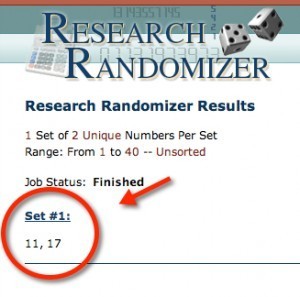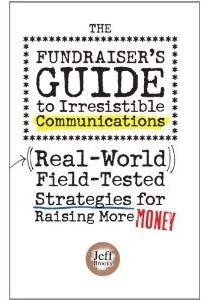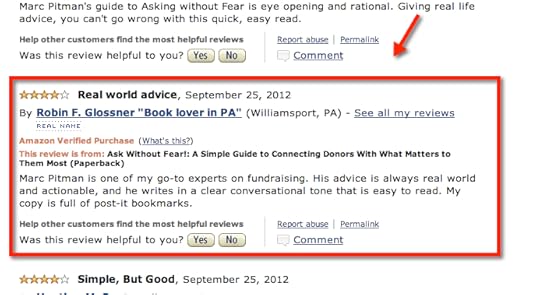Marc A. Pitman's Blog, page 50
October 25, 2012
Kindle Fire HD and Google Nexus 7 Giveaway Winners Announced

Ask Without Fear!
turns 5 on April 1, 2013!
But I’m starting to celebrate now. 
Over the last few weeks, I’ve been emailing people on why fundraising tips email list and on Fundraising Kick and telling people on Twitter, Facebook, and Google+ that I was giving away 2 tablets, a Kindle Fire HD and a Google Nexus 7.
The only way to enter was to write a review of Ask Without Fear! on Amazon by 10 a.m. Eastern on October 25.
Good, Bad, or Ugly
I was clear that I wanted honest reviews: good, bad, or ugly. The number of stars wouldn’t increase the odds of being chosen. And to make sure it was truly random, I used Randomizer.org. (Thanks to the folks at Reliant Studios for telling me about Randomizer!)
And the winners are…
And the winners are #11 and #17!!!
#11 is Jon Swanson creator of cool things like 300 Words a Day and a pastor in Fort Wayne, IN. He wins the 32GB Kindle Fire HD.
#17 is Robin Glossner director of development at James V. Brown Library in Williamsport, PA. She’ll be receiving the 16 GB Google Nexus 7.
Both tablets are making headlines. Both are the maximum memory available at the time of this writing.
This is the start of the celebration
I’m not sure what else I’ll do to celebrate the first 5 years of Ask Without Fear!. But like celebrations at Disney, I’m planning on making this last 18 months! Feel free to submit your ideas below.
The actual reviews
Here are the reviews Jon and Robin wrote.
(c) The Fundraising Coach, LLC
Get 100 donors in the next 12 weeks? Learn how: 100 Donors in 90 Days!
Other Possibly Related posts:
Kindle edition of “Ask Without Fear!” reformatted!
Don’t fire blanks with your email
Fundraising Coach Nonprofit Goodies Giveaway
October 23, 2012
Donor retention: Dance with the ones who brung ya
 Did you know the average nonprofit loses 7 donor out of 10 every year?!
Did you know the average nonprofit loses 7 donor out of 10 every year?!
Indiana University’s Adrian Sargeant, author of great books like “Building Donor Loyalty [Amazon affiliate link], has done statistical research proving this. But even ordinary, non-academicians know this to be true. Every year, a handful of my fundraising colleagues give year-end gifts to 10-12 nonprofits. Constantly, only 7 out of 10 even acknowledge the gift. I’m not talking about a personal note or call. They don’t even send an fill-in-the-blank letter!
A sure way to go out of business
Businesses don’t survive if they lose 70% of their customers each year. Neither do nonprofits. While successful donor acquisition is necessary, so is effective donor retention.
I was seriously encouraged last week when I spoke with the serial entrepreneur Jay Love. Most recently known as the creator of eTapestry (which was purchased by Blackbaud), he’s now going out on his own and launching a brand new donor management database company called Bloomerang. What makes it unique in a landscape of Blackbaud, DonorPerfect, or (gasp) Salesforce, is that Bloomerang is obsessively focused on donor retention.
Love “gets” donor databases, so this has everything a nonprofit needs for managing gifts and relationships. But this time he’s brought on Adrian Sargeant and baked all of Sergeant’s research right into the database. For example, each time you log into your database, you see your overall donor retention percentage. (Did I mention Adrian Sargeant is redefining retention away from annual giving to meaningful touches every 90 days?)
Bloomerang drills retention down to the individual level by telling you if the donor interacted with an email or social media page or if they passed it on to others. This helps you determining what is meaningful for each donor.
So often, we focus on donor acquisition while neglecting the donors we have. Or worse, we take those donors for granted. So they stop giving.
Ways to keep donors
Last week’s Movie Monday, “Getting board members to raise money joyfully,” was filled with tips on how one nonprofit effectively engaging their board in thanking donors. It wasn’t anything revolutionary. The board members:
Left voicemails saying thank you,
Wrote notes showing donor impact, and
Forwarded emails from the nonprofit.
None of it took much time, but the donors loved it! After a year of intentional donor retention strategy, those donors gave more the second year. And were more convinced their money was making an impact.
Check out the video yourself at: http://www.501videos.com/cmd.php?Clk=4870343
Dance with the one that brung you
Our nonprofits wouldn’t exist if it weren’t for the generosity of our past donors. So as you plan your yearend fundraising letters and appeals, be sure to thank donors too. No matter how great your staff is, without those donors, your organization wouldn’t be able to do its work. You know that.
Let them know that you know.
Let’s commit to treating our donors in a way that encourages them to stick with us year after year.
(c) The Fundraising Coach, LLC
Get 100 donors in the next 12 weeks? Learn how: 100 Donors in 90 Days!
Other Possibly Related posts:
The Folk Dance of Nonprofit Organizational Development
Printed Donor Lists: To do or not to do?
7 ways to thank a donor
October 9, 2012
Is announcing your goal killing your fundraising?
 Fundraising is a funny thing. When combined with casting a vision, telling people how much you’re trying to raise can be a powerful motivator.
Fundraising is a funny thing. When combined with casting a vision, telling people how much you’re trying to raise can be a powerful motivator.
But could announcing your goal kill your ability to raise funds?
Neuroscience and goal setting
Watch this 3 minute video by Derek Sivers.
If you don’t see the video above, you can link to it here http://www.ted.com/talks/derek_sivers_keep_your_goals_to_yourself.html.
In just three minutes, Derek reviews 90 years of research that indicates:
“Telling someone your goal makes it less likely to happen.” – Derek Sivers
Talking about your goal makes your brain think you’ve achieved it
In classic capital campaigns, you aren’t supposed to publicly announce your goal until you’re 60% – 75% of the way there.
Have you been part of a campaign or fund drive that didn’t hit its goal? Maybe the reason you failed was that your committee got the “rush” of accomplishing the goal just by talking about it.
If this sounds like you, here are three things you can do:
Stop having a singular focus on your fundraising goal
Expand your focus and discussion to include things like setting up appointments and making asks.
Keep connecting your team with the mission
If talking about the monetary goal lessens the chance of accomplishing it, get the solicitors on tours or quick meetings with the people being helped. Being around them will remind the solicitors that money still needs to come in. And it will keep them motivated to get in front of donors.
Make sure to congratulate your team on gifts of all sizes
Solicitors, especially volunteers, get discouraged when donors come in lower than they expected. But that’s why we set up things like www.GiftRangeCalculator.com recommend having 5 prospects for every gift level. So be sure to encourage the solicitors and thank them for keeping the asks moving forward! Even smaller gifts are better than no gifts.
Those are my recommendations
What do you think? Is talking about your goal motivating or fatal? Tell us in the comments!
(c) The Fundraising Coach, LLC
Get 100 donors in the next 12 weeks? Learn how: 100 Donors in 90 Days!
Other Possibly Related posts:
Free Goal Setting Mastermind Call!
Wreck the resolutions! Join the Free Goal Setting Mastermind Call
A fun look at SMART goal setting!
October 3, 2012
How PBS can turn the presidential debate into fundraising gold
 First off, I didn’t watch the debates tonight. I find political debates to be more akin to rehearsed speeches than engaging in dialogue.
First off, I didn’t watch the debates tonight. I find political debates to be more akin to rehearsed speeches than engaging in dialogue.
But my Twitter stream was filled with tweets about the presidential debate.
Tweets were all over the place. But Big Bird got a lot of space.
Opportunistic Fundraising
Apparently there was a comment about removing funding for PBS from the budget. This is just the thing that savvy nonprofits can use to raise millions of dollars.
National exposure
live social media attention
ability to locate fans
ability to inflame a passionate base
NPR has used this in the past with Ira Glass doing spots during news shows when Congress threatens funding. And Planned Parenthood is the master at this. They raised an additional $3 million during the flap with Komen.
Big Bird T-shirts
RT @marcapitman: PBS Fundraising opportunity! RT @librarianry: Who has started printing SAVE BIG BIRD t-shirts? #smallbusiness
— Ruth Marie Sylte (@rmsylte) October 4, 2012
As you can see in the tweet above, the Twitter user @librarianry had a great idea: “Who has started ‘Save Big Bird’ t-shirts?”
That reminded my of Peter Shankman’s story about printing t-shirts when Titanic was released that said, “It sank. Get over it.” He sold out in hours. Better still media loved the story.
Whether you’re for or against any of the presidential candidates (there are more than two), PBS supporters could do this here. They could print t-shirts. And ask for gifts.
Telling people “we exist because of your small gifts” isn’t convincing. But rallying them to “Help us save Big Bird” would get lots of support. Start with the t-shirts but use them to tell the story. If done in a fun, tongue-in-cheek manner, media outlets and social media users will amplify this for at least the next few days. PBS could drive people to a landing page that sells the t-shirt or offers a “make a donation” option. It’d be cool to have an autotuned message there in the spirit of Mr. Rogers’ “Garden of Your Mind” or Bob Ross’ “Happy Little Clouds.
NPR and other public media might be able to piggyback on this and amplify it further.
Sound off
I believe learning to catch the waves of public interest is an important part of a healthy fundraising program.
What do you think? Is this kind of opportunistic fundraising helpful to nonprofits? Or does it damage the brand? Leave a comment with your thoughts!
(c) The Fundraising Coach, LLC
Get 100 donors in the next 12 weeks? Learn how: 100 Donors in 90 Days!
Other Possibly Related posts:
Don’t let the debt ceiling debate take your fundraising down the drain
Don’t turn to the “dark side”
3 Tips for Effective Fundraising Letters
September 25, 2012
Want to drive online giving? Send a letter
Studies continue to show that online giving is the fastest growing fundraising channel. But not every nonprofit is experiencing this stellar growth.
The best way to grow online donations
So what’s the best way to grow online donations? A firm called Dunham+Company recently released a study that has counterintuitive results. The study says direct mail is a growing source for online gifts.
In fact, it says more than times as many donors say they gave online because of being prompted by a letter than by an email.
3 times!
Review your fall fundraising letters
As you prepare to send out your fall fundraising letters, make sure they:
clearly state the link for donors to make a gift online
make the URL easy to remember–something short like “www.yournonprofit.com/donate” would do the trick
and that the page they are directed to is where they can put in their credit card information
Test your own online giving
You may think you have an easy online giving form. But it probably isn’t as good as you think. Today, make an online gift to your nonprofit and pay attention to how it “feels” to go through the process. Also, take note of any confusing parts in the process.
Then get them fixed.
The harvest is now
We are now in the most generous season of the year. People are already making end-of-year gifts. Do your best to make that process as easy as possible. And a simple online giving option is about the easiest there is!
And if you were hoping to ditch direct mail in favor of email, remember the Dunham+Company study. You might be drastically reducing the amount of money you’ll raise. (Obviously, when doing direct mail, be sure to have an easy way for donors to mail money to you too! Don’t just send a letter with a link!)
What are you doing to improve your online giving?
In the comments, let us know what you’re doing to improve your online giving.
(c) The Fundraising Coach, LLC
Get 100 donors in the next 12 weeks? Learn how: 100 Donors in 90 Days!
Other Possibly Related posts:
Question Marc: Is online pledging a good option?
Online fundraising idea for Black Friday & Cyber Monday
Using Twitter and Facebook in your year-end fundraising letter strategy






September 21, 2012
Political junk mail can hurt your fall fundraising letters
[image error]
If you’re like many nonprofits, you’ve sent a fall fundraising appeal this month and you plan on sending one towards the end of the year.
You might want to reconsider that plan.
NPR did a great piece on political direct mail. It’s definitely worth listening to, but here are two take-a-ways:
It’s going to be noisy in the mail box
There is going to be a lot more mail in people’s mailboxes. According to NPR, if you thought the political ads on TV were bad, you haven’t seen anything yet. Political junk mail is about to hit.
So you may want to add another mailing or two to ensure your fundraising message is received.
Opt for earlier deadlines
If you use a mailhouse, move up your entire mail schedule by 2 weeks. Political mail slows down all mailings, at least for the smaller nonprofits–which are most of us. So build in some buffer time. It’s far better that the letter your donor normally receives on December 15 gets to them on December 1 rather than January 2.
So build some margin into your schedule.
I’d encourage you to listen to the interview over at NPR. One of the direct mail experts has a great observation about plain mail vs. colorful graphics.
Next Tuesday, I’ll be sharing a way to drive online donations. You can be among the first to get this article by signing up for my free email list at: http://fundraisingcoach.com/subscribe/.
(c) The Fundraising Coach, LLC
Get 100 donors in the next 12 weeks? Learn how: 100 Donors in 90 Days!
Other Possibly Related posts:
Direct mail fundraising still has legs
Year-end fundraising through the mail
Bulk fundraising letters
September 17, 2012
Free Nonprofit Academy Telesummit
Last spring, I was privileged to be part of the first Nonprofit Telesummit. It was so popular, we’re doing it again.
This fall’s Telesummit is being held from September 26-28…right at your telephone!
Since it’s free, you can come to one session or join them all.
12 of us will be showing you how to raise money more effectively. Here’s what you’ll be eligible to learn:
WEDNESDAY
How to Find and Share Boring 2 Brilliant Nonprofit Stories, Lori L. Jacobwith
State and Federal Compliance Requirements for Nonprofits, Greg McRay
How to Make Your Grant Proposal Stand Out From the Pack, Betsy Baker
Mastering the Art of Conversational Fundraising, Kent Stroman
THURSDAY
Multi-Channel Marketing, Mike Brenhaug
Engaging Your Board in the Raising of Money, Kirsten Bullock, MBA, CFRE
Create a system for WOW stewardship that leads to major gifts, bequests, and lifetime donors, Pamela Grow
No More Excuses! Turning Data Into Dollars, Sheri Chaney Jones
FRIDAY
Google+ for Nonprofits, Marc A. Pitman
Best Practices for Engaging Volunteers with Social Media, Jessica Young
The Secret to Painless Giving: “Found Money”, Scott Thomas
6 Steps to a Simple Fundraising Plan, Sandy Rees, CFRE
The best part? IT’S FREE. And the presenters are giving lots of special bonuses for people taking part.
For more information and to register for this free event go to:
http://thenonprofitacademy.com/
(c) The Fundraising Coach, LLC
Get 100 donors in the next 12 weeks? Learn how: 100 Donors in 90 Days!
Other Possibly Related posts:
Nine Free Fundraising Classes
Free nonprofit tools from 10 different experts!
Free AMA Nonprofit Marketing Conference 2011 registration contest
September 13, 2012
Lying to donors or good business sense?
 There have been some pretty high profile news stories of direct mail firms and telemarketers pocketing 75% to 85% of the money raised for a charity. The latest was reported yesterday on NPR reporting on a Bloomberg investigation of InfoCision’s work for charities like the American Cancer Society.
There have been some pretty high profile news stories of direct mail firms and telemarketers pocketing 75% to 85% of the money raised for a charity. The latest was reported yesterday on NPR reporting on a Bloomberg investigation of InfoCision’s work for charities like the American Cancer Society.
75% to 85%?
That prompts the question:
What were they thinking?
Paying for fundraising by giving the solicitor a percentage of the money raised is expressly prohibited by the Association of Fundraising Professionals in its longstanding Code of Ethics. So what were these big charities thinking by agreeing to such arrangements?
Any veteran in business development or nonprofit fundraising knows that “acquisition” strategies – processes that help bring in new customers or donors – often cost more than the first sale or gift. I remember hearing in one seminar that an acquisition mailing might cost up to $1.25 for every dollar raised.
The most respected practitioners remind us that the value isn’t in the one mailing, it’s in the giving over the entire relationship with the donor. Looking at the acquisition strategy in isolation is a severe distortion. It needs to be seen in context of overall fundraising for the year and, especially for startups, in the context of overall fundraising over the next many years.
So why not budget for fundraising?
If acquisition can cost alot up front, and if paying solicitors based on a percentage of money raised is deemed unethical by the biggest professional association of fundraisers, why wouldn’t a portion of a nonprofit budget be for costs of fundraising?
Just make it a part of the budget. All donations that come in go directly to the charity. All moneys the charity pays others, including its employees, comes from its budget.
Would that solve the problem?
I think it’s really important to also look at the overall picture: is more impact being made? Are more people being helped and without the effort? Is more research being funded? Not just from acquisition approaches but from the entire revenue picture of the charity?
Well intended (presumably) but confused
I think these watch dog attempts are, presumably, well intended. Lying to donors is never good business sense. Lies should never be tolerated. Ever. If someone is raising money for a charity, that money should go to the charity. Period.
But in an increasingly complex fundraising space, charities need to have the flexibility of experimenting with different initiatives to fund their cause. I think one of the biggest problems facing nonprofits is a sentiment that was shared by Leslie Lenkowsky in a recent article in the Chronicle of Philanthropy.
“The public expects charities to behave charitably even if they are not acting in an economically rational way.”
What?! Isn’t “not acting in an economically rational way” the equivalent of going bankrupt?
The work of nonprofits make our world a better, more whole, and more beautiful place. Requiring them to act in irrational ways that cause them to go bankrupt will remove all the good they are doing. Is that really the intent of these news stories?
I hope not.
One takeaway for nonprofits
These media reports should cause all of us in nonprofits to take a hard look at our 990s. These are publicly available to everyone and often where the stories start.
If you were an investigative reporter, would the 990 financials make you question your charity’s integrity?
We need to be able to tell the stories of the numbers. Why are they what they are? Is this an anomaly or part of a trend? We can even use space provided by sites like GuideStar.org to help tell that story.
What about you?
What do you think about these high profile media stories? Do you think budgeting for costs versus paying a telemarketer a percentage of funds raised is just a shell game?
(c) The Fundraising Coach, LLC
Get 100 donors in the next 12 weeks? Learn how: 100 Donors in 90 Days!
Other Possibly Related posts:
Ten Things to Do Today to Get Business
Question Marc: Is online pledging a good option?
Good news about Millennials and Fundraising
September 12, 2012
Fundraising Training in Lewiston, Maine
I’m honored to be doing a fundraising training in Lewiston, Maine today at 11:00.
It’s open to Chamber members and non-members. I’m sure you can pay at the door but since lunch is included with the price, I bet they’d love a call so they can have enough food.
Call them at (207) 783-2249 to register or find out more at: http://www.androscoggincounty.com/events/eventdetail.aspx?EventID=1670
(c) The Fundraising Coach, LLC
Get 100 donors in the next 12 weeks? Learn how: 100 Donors in 90 Days!
Other Possibly Related posts:
Job Opportunity – Bangor, Maine
Job Opening: Maine’s Childrens Home for Little Wanderers
Job opening: Development Director, Hospice of Southern Maine
September 11, 2012
3 more contrarian tips for writing successful fundraising letters
 Yesterday, I sent my Fundraising Kick members 3 contrarian tips on writing successful fundraising letters. Here are three more tips that seem to go against what we’d expect.
Yesterday, I sent my Fundraising Kick members 3 contrarian tips on writing successful fundraising letters. Here are three more tips that seem to go against what we’d expect.
These tips come from an amazing new book by Jeff Brooks called The Fundraiser’s Guide to Irresistible Communications. I’ve been a fan of Jeff’s for almost ten years. His writing is clear, to the point, and tested in reality. Jeff knows his stuff. He’s one of the top writers of fundraising letters in the country. (If I were a betting guy, I’d put him in the top two.)
This book is packed with real, tested tips, not ephemeral theories. Ignore them at your peril.
Use a serif font and keep it black
When writing fundraising letters, it’s always best to use font with serifs – those little design on the ends like you’d see in Times New Roman – rather than a sans-serif, like Arial.
Tests show that serif fonts are easier to read than sans serif. And in direct mail fundraising, you need to make your letters easy to read! If you don’t, they’re destined for the trash can before you even have a chance to tell your story.
Jeff says that sans-serifs are ok with headlines, but be sure to keep all the fonts black. Not white on black. Not any other color. This is again about readability. Your letter may look pretty with different colored fonts, but your goal shouldn’t be a pretty letter. Your goal should be an effective fundraising letter. And it’s shown time after time to be more effective, and easier to read, when your letter’s font is black.
Bigger is better for fonts
Another factor in making it easier to read is the size of your fonts. I think many of us like 11 point font because it helps us get more words onto a page. But since direct mail readers tend to be older, we need to design our letter for older eyes. Jeff says the smallest font you should use in a letter is 12 point. A little bigger could be even better.
Don’t worry if this bumps your text onto another page. At another point in the book, Jeff says that longer letters get better response than shorter letters. Totally against what I prefer. But we’re not writing letters to meet our preferences. We’re writing letters to fund our nonprofit!
Choose conversational over grammatical
A third point he makes is that fundraising letters work best when they sound like someone’s talking to you. Short sentences and smaller words are preferable. Paragraphs don’t need to start with the premise and don’t need to be 3-5 sentences.
Sometime paragraphs should be just one line.
And sometimes you’ll find using only a fragment is more effective than using a complete sentence. Just one phrase. It can add emphasis and a little drama. Something that piques people’s curiosity enough to read further. He’s not advocating sloppy writing. It needs to be focused and clear. But this isn’t highschool English. This is fundraising. And since people give to people, conversational letters out-perform thesis-paper-like letters.
These seem contrary to our preferences, don’t they? The goal of a fundraising letter should be to move a person to the action of making a gift. The goal is not to win a Pulitzer Prize. It’s not even to make your board chair happy. (Why is he or she editing the letter anyway?!)
These are just three of the time-tested tips in Jeff’s book. The Fundraiser’s Guide to Irresistible Communications is packed with loads more.
If your job involves writing or approving fundraising letters this fall, be sure to test tips! In addition to this great book, Jeff has a helpful (and fun) blog at www.FutureFundraisingNow.com.
(c) The Fundraising Coach, LLC
Get 100 donors in the next 12 weeks? Learn how: 100 Donors in 90 Days!
Other Possibly Related posts:
3 Tips for Effective Fundraising Letters
Fundraising letters that connect with your donors
How to write effective fundraising letters






